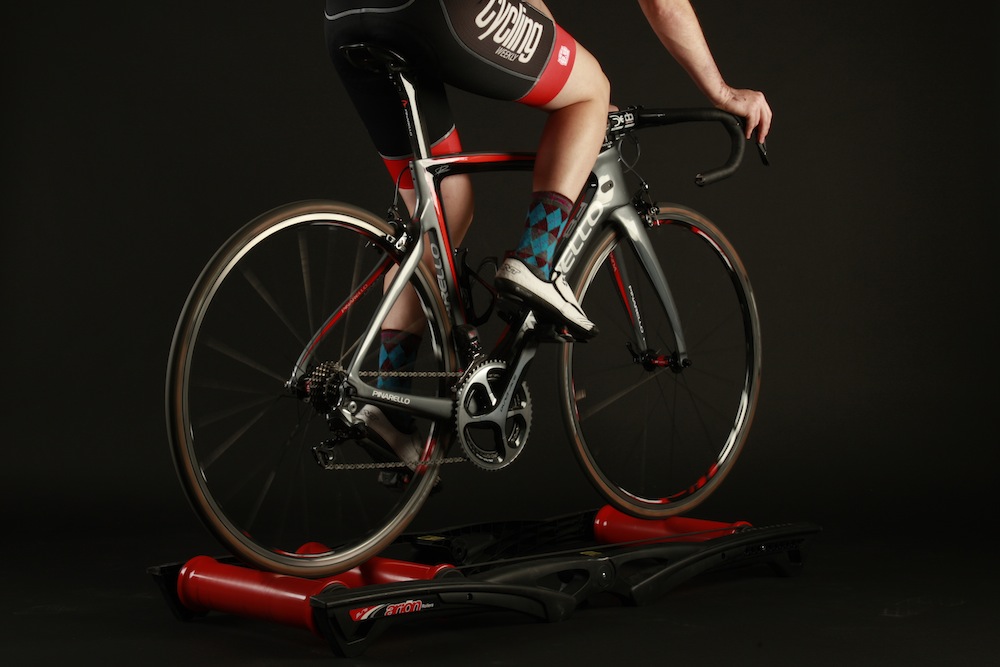Is turbo training damaging your lightweight carbon frame?
We asked the experts if riders should worry about their carbon frames whilst exploring Watopia


It’s the stuff of nightmares: the emergence a tiny hairline crack in a carbon frame is enough to leave any cyclist sweating, especially if it later transpires that the cause lies outside the terms of warranty.
Several brands have clearly stated that their bikes are not designed or tested to be fixed into a turbo trainer, with carbon frames under particular scrutiny.
However, this month German manufacturer Canyon approved a selection of models for turbo use, including the Aeroad, Ultimate, Endurace, Grail, Inflite, Speedmax, and Exceed.
To allow for this about turn, the headline sponsor of e-racing team Canyon ZCC says it updated the testing procedures at its Koblenz factory.
Head of R&D, Michael Kaiser said: “We’ve designed and added a new test to our quality assurance processes to precisely simulate the stresses that using a turbo trainer puts on a bike’s frame.”
The approval comes with two caveats: the trainer must clamp on to the bike’s rear axle and required accessories supplied by the trainer’s manufacturer, such as special axles, must be used.
The announcement will come as great news for Canyon owners. But what about the rest of us?
“Most frames are fine if you're just spinning along, in the saddle” says Lee Prescott, who builds bespoke steel frames at Meteor Works and also fits up riders buying bespoke carbon bikes from Italian brand Werking at his Warwickshire studio, Velo Atelier.
He reckons things change when you amp it up.
“If you're doing pyramids, FPT tests, where you're starting to put more torque through the frame, if you have a super lightweight or cheap carbon frame, I wouldn't do it.
“Normally if you're out on your bike and put that level of torque through the bottom bracket, the physics of it is that the frame will just react against the force. When you're locking it into a turbo, you're essentially applying a big force that the frame can’t then get rid of. It’s having to absorb it through the material.”
Budget vs premium turbo trainers: the differences explained
Frames with super thin seatstays, designed to add to compliance, Prescott highlights as a particular risk.
As well as high intensity efforts, he warns against being too clumsy when mounting and dismounting.
“Because you are higher up when on the turbo, I have seen instances where people have sort of fallen off when dismounting. Because the bike is locked in, this causes a twist and can result in a cracking at the seatstay, down by the dropout.”
>>> Rollers vs Turbo: which is better?
“It doesn't make a difference if your turbo is direct drive or not. If you’ve got a really lightweight frame, and you want to do indoor training, I think rollers are the best thing,” he says.

Roller technology has moved on with smart trainers: you can now find models with variable resistance and the added element of balance can make indoor sessions much more interesting, too.
Confidence in carbon's compatibility with turbo trainers varies, however. When Cycling Weekly asked Taiwanese brand Giant, it said that all of its frames can be used with turbo trainers, provided the correct axles are used and the bike is fitted to the machine correctly.
A representative added that the brand sees no warranty claims due to damage via turbo trainers, though it does see claims where bikes have fallen out due to being incorrectly secured.
Turbo trainer brand Wahoo is confident that readers don't need to be eschewing their indoor sweating habits right away.
"[The trainers in] Wahoo's Kickr range are absolutely safe to use with any compatible bike," said Rowley Clifford, UK marketing manager at Wahoo.
"Our engineers work closely with some of the industry's biggest brands to ensure that, when mounted correctly and within the relevant weight restrictions, riding on a stationary bike doesn't pose any risk to your frame.
"As such, we welcome the move from Canyon to put consumers' minds at ease by officially approving use of their bikes on turbo trainers."
Canyon's UK marketing manager, Jack Noy pointed out that cracks in the frame may not be the most pressing concern for the majority of users.
"The service team has tended to see corrosion related problems with heavy turbo trainer use, as opposed to the forces leading to material failures. It is crucial to protect your bike from excessive sweat and keep on top of cleaning and maintenance."
Our take...
Cycling Weekly's tech testers have been completing turbo sessions on carbon bikes for years, and we've not found a crack, yet.
The majority of brands can’t approve the practice because factory testing doesn’t take into account the forces applied. This may change in future years as indoor training and racing becomes more prevalent, but for now, if you are worried, rollers and the likes of Wattbike represent a reliable alternative.

Thank you for reading 20 articles this month* Join now for unlimited access
Enjoy your first month for just £1 / $1 / €1
*Read 5 free articles per month without a subscription

Join now for unlimited access
Try first month for just £1 / $1 / €1
Get The Leadout Newsletter
The latest race content, interviews, features, reviews and expert buying guides, direct to your inbox!
Michelle Arthurs-Brennan the Editor of Cycling Weekly website. An NCTJ qualified traditional journalist by trade, Michelle began her career working for local newspapers. She's worked within the cycling industry since 2012, and joined the Cycling Weekly team in 2017, having previously been Editor at Total Women's Cycling. Prior to welcoming her first daughter in 2022, Michelle raced on the road, track, and in time trials, and still rides as much as she can - albeit a fair proportion indoors, for now.
Michelle is on maternity leave from April 2025 until spring 2026.
-
 Gear up for your best summer of riding – Balfe's Bikes has up to 54% off Bontrager shoes, helmets, lights and much more
Gear up for your best summer of riding – Balfe's Bikes has up to 54% off Bontrager shoes, helmets, lights and much moreSupported It's not just Bontrager, Balfe's has a huge selection of discounted kit from the best cycling brands including Trek, Specialized, Giant and Castelli all with big reductions
By Paul Brett
-
 7-Eleven returns to the peloton for one day only at Liège-Bastogne-Liège
7-Eleven returns to the peloton for one day only at Liège-Bastogne-LiègeUno-X Mobility to rebrand as 7-Eleven for Sunday's Monument to pay tribute to iconic American team from the 1980s
By Tom Thewlis